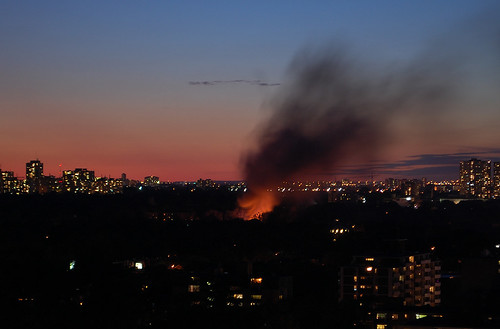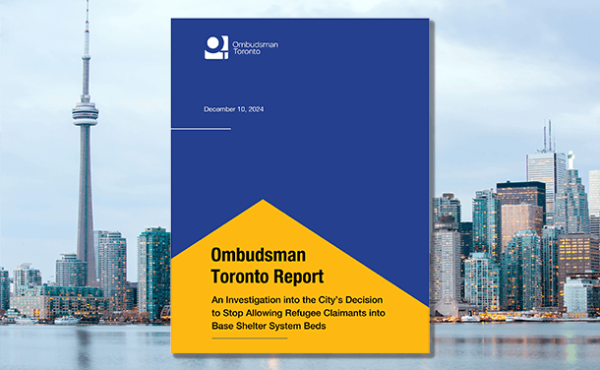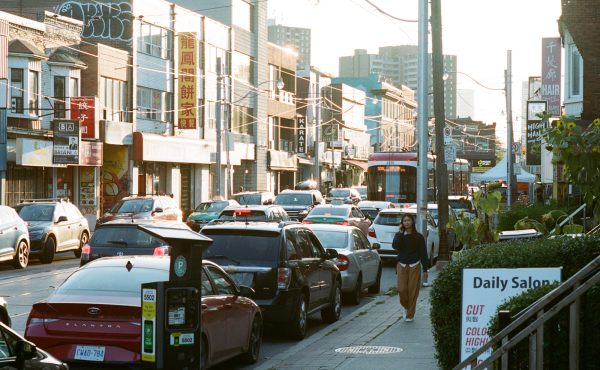
Occasionally on this blog, I’ve talked with pride of my 24th-floor balcony view in the deep south of Parkdale. Mostly I brag about watching storms roll in from the west or the tremendous sunsets, but last night the view was of a much different nature.
As I was finishing off dinner, I spotted some smoke rising into the sky just east of Roncesvalles and south of Howard Park Avenue. Within minutes, huge flames were dancing above the tree line. The Star reports today that a residential house caught on fire after a discarded cigarette ignited a backyard blaze. No one was injured but the house is completely gutted.
I called Spacing Radio host David Michael Lamb (also a CBC Radio News anchor), who lives very close to the scene, to see if it was his house in flames (luckily it wasn’t). He gave me a great on-the-spot report where he pointed out that the scene had already attracted a slew of local photographers including a few professionals he knew. My friend Bouke Salverda, a regular Spacing photographer, was on my balcony when we first spotted the blaze and suggested we walk over to take some photos for ourselves. Since we were lazy and drinking beer, we stayed safely away and took long-distance shots of the event instead (the photos are 20-second exposures in succession).
As the night wore on, the fire got me thinking about how dramatic neighbourhood events like this have become a photo orgy of sorts. While people have always captured horrific scenes with their cameras, digital imagery has upped the ante. Instead of a location being filled with concerned neighbours, it can now have just as many photographers or videographers milling about. For instance, the Queen West fire from February 2008 was insanely well-documented by local amateur photographers. The current City strike is inspiring a ton of images of stacked garbage bags in parks. Even when I went to Newmindspace’s Bubble Battle this weekend, I think there were more people taking photos than actually blowing bubbles.
I’m not concluding this is a good or bad development in our behavioural patterns, but noting that over the last few years we’ve seen a change in how we particapte in these type of events.



7 comments
One of my favourite shots by (professional) photographer Devin Jeffrey:
http://devinjeffreyblog.wordpress.com/2009/07/11/christie-pits-park/
<3
You’ve got some pretty awe-inspiring photos from your Observatory, Matt… I only wish I’d had my D40 on me when I noticed the fire:
http://www.flickr.com/photos/tapesonthefloor/3719868379/
That’s from Richmond/Spadina, about 11 floors up.
One place where the advent of cell phone cameras has made a big difference is at concerts. When I was going to concerts in the 90s there were usually strict “no photography or recording devices” clauses in the fine print on the back of the tickets. I don’t know if those clauses are still there, but if they are, they are not easily enforceable now that everyone’s cell phone is a camera (and often also a video camera). Certainly it is not hard to find concert footage on YouTube.
As much as I’m a part of this paparazzi-style phenomenon it does bug me sometimes. Especially at events like the Bubble Battle where there really were as many photographers as bubble blowers (tho some were both) and it does make you think you’re ruining it sometimes. I feel like it can make people feel more like performers than participants, which isn’t the idea behind these kind of events.
The saturation coverage of news events is a bit different though. I’m not sure there’s a downside to that. Unless you’re a photojournalist perhaps. There are already agencies that exist purely of news images taken by ‘the public’.
Before digital photography, most people had a 36 limit with their 35mm cameras. That limit also prevented people from taking spur of the moment opportunities.
Now with digital cameras and cell phone cameras, people can take photographs without the worry of paying for mistakes, blurring, unwanted, or duplicates.
I concur with Brent and Miles. I was at the Montreal Virgin Festival, and half the audience was watching the entire concert on their 3 inch video camera display’s while they take pictures and videos. Personally, I always feel that it spoils the experience (or in the Bubble Battle’s case, discourages any experience at all), but I guess that’s what we do these days… We sacrifice a bit of our initial experience so we can watch and share them whenever we’d like. Not a bad trade off, but somewhat an obnoxious obligation in my opinion 😉
Anyone remember the great footage from several photographers of the Downsview explosion last year when the fire turned into a mushroom-cloud, complete with shockwave (that shattered hundreds of local windows) – how would the mainstream media capture that?
You could go back to 1992 LA even to see how the camera and camcorder-equipped everyman made an impact.